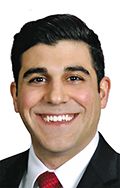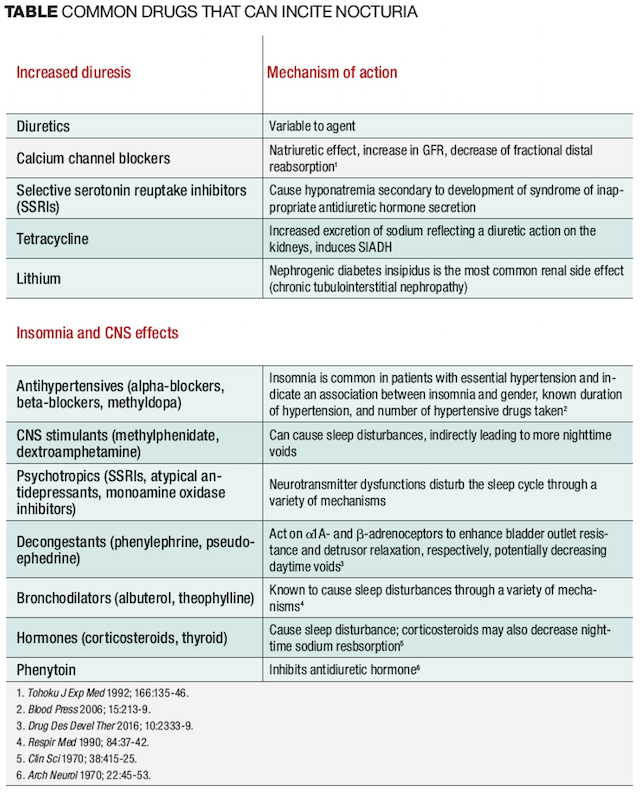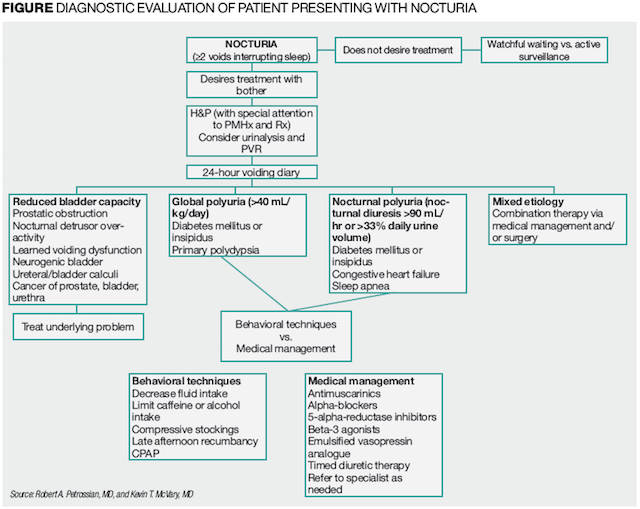Publication
Article
Urology Times Journal
Management of nocturia: An unmet need in LUTS
Author(s):
In this article, we review the underlying causes of nocturia and outline an approach to its diagnostic evaluation and treatment.


The definition of nocturia has been as nebulous as its etiology and management. In 2002, the International Continence Society defined nocturia as waking up at night at least once to void (Neurourol Urodyn 2002; 21:179-83). However, clinically relevant nocturia is generally accepted among urologists to indicate two or more voids that are preceded and followed by sleep. It is worthy to note that neither definition accounts for the patient’s degree of bother from nocturia, though waking twice or more from sleep to void has been associated with impaired quality of life (Eur Urol 2010; 57:488-98).
The economic burden of nocturia is substantial and includes injuries from falls, lost work productivity, and intangible losses such as distress, behavior changes, and confinements. The estimated financial impact is considerable, as indirect costs have been estimated at $61 billion per annum (Neurourol Urodyn 2014; 33 [suppl 1]:S10-4).
Also see: Beta-3 agonist significantly reduces urge incontinence
In this article, we review the underlying causes of nocturia and outline an approach to its diagnostic evaluation and treatment.
Nocturia is a gender-neutral entity with multifactorial underlying causes. While many studies have investigated the epidemiology of nocturia, the lack of standardized terminology has obscured research results. In a large population-based study, Tikkinen et al concluded that nocturia is more common in women under age 50, has about the same prevalence among men and women ages 50-59, is more frequent in men above age 60, and increases in prevalence more rapidly with age in men than it does in women (J Urol 2006; 175:596-600).
McVary et al found that most men with LUTS identify their chief LUTS complaint as nocturia and that, importantly, this symptom persists without improvement in nearly half of men (Urology 2015; 86:862-7). Echoing this unmet need in LUTS, the AUA guidelines for non-neurogenic overactive bladder (OAB) note that most of the reviewed studies included robust data on urinary frequency and incontinence, but “only a handful reported nocturia data” (J Urol 2015; 193:1572-80).
Next: "The relationship between sleep and LUTS deserves special mention given the role of sleep in overall health and quality of life
The relationship between sleep and LUTS deserves special mention given the role of sleep in overall health and quality of life. Nocturia by definition disrupts the normal sleep cycle by interfering with sleep efficiency and prolonging sleep latency. Importantly, nocturia has been associated with increased mortality risk. The underlying mechanism for this is conceivably the greater risk of metabolic syndrome in nocturic patients as well as increased nighttime falls and fractures en route to the toilet (J Urol 2011; 185:571-7).

Along these lines, it is essential to recognize and rule out sleep disorders that can contribute to nocturia. Commonly encountered sleep disorders include sleep apnea, insomnia, parasomnias, and restless legs syndrome.
As clinicians who frequently encounter this vexatious entity, it is essential for urologists to approach patients with nocturia systematically. A complete history and physical should be obtained, with particular attention to medical history (hypertension, diabetes, heart disease, kidney disease, sleep disorders) and common medications that can incite nocturia (table).
Read: Investigational device shows promise for OAB
One must then assess the extent of the patient’s bother and whether or not he or she desires treatment for nocturia. In the authors’ experience, some patients with a seemingly high number of nighttime awakenings are indeed not bothered by their nocturia; these patients do not warrant further nocturia treatment, although this is not to say that potential underlying holistic medical problems should be discounted.
If the patient does desire treatment, a urinalysis should be considered to evaluate for proteinuria, glucosuria, or other abnormalities. As well, a post-void residual may also be obtained to evaluate for incomplete emptying. A 24-hour voiding diary is a valuable and cost-friendly objective tool that should be used to evaluate OAB symptoms, the quantity and type of liquid intake, and frequency and volume of voids (bit.ly/2udTApp).
Four main categories of nocturia
The urologist should be aware of the four main categories that nocturia falls under: global polyuria, nocturnal polyuria, reduced bladder capacity, and mixed (“Campbell-Walsh Urology,” 11th ed. Philadelphia: Elsevier, pp.1821-35).

Global polyuria is defined as 24-hour urine output of >40 mL/kg and is caused by primary polydipsia, diabetes mellitus, or diabetes insipidus. On the other hand, nocturnal polyuria lacks a standardized definition, though commonly used criteria include nocturnal diuresis >90 mL/hr or >33% of daily urine. Nocturnal polyuria has numerous causes such as increased presomnial fluid intake, congestive heart failure, peripheral edema, sleep apnea, or diabetes mellitus or insipidus (Indian J Urol 2008; 24:289-94). Decreased bladder capacity is an umbrella term that includes prostatic obstruction, nocturnal detrusor overactivity, learned voiding dysfunction, neurogenic bladder, ureteral or bladder calculi, or cancer of the bladder, prostate, or urethra.
The figure depicts a comprehensive diagnostic evaluation for a patient presenting with a complaint of nocturia.
Next: Treatment
Treatment
Treatment for nocturia should begin conservatively regardless of the underlying cause. One should start with behavioral techniques and only move to medications and/or procedures if clinically justified. The intervention should be tailored to the individual by aiming at the underlying problem: global polyuria, nocturnal polyuria, reduced bladder capacity, or mixed.
Behavioral techniques to attenuate nocturnal polyuria include decreasing bedtime fluid intake, minimizing caffeine and alcohol intake, or using compression stockings or late afternoon recumbency to mobilize retained fluid for edematous conditions. Nocturia in those with sleep apnea can be improved with the use of continuous positive airway pressure. The judicious administration of medications, such as diuretics earlier in the day or antidiuretics at bedtime, may be helpful in select individuals.
Also see: General urologists less likely to utilize third-line OAB treatments
Though frequently prescribed by many urologists, by and large, alpha-blockers, 5-alpha-reductase inhibitors, and antimuscarinics have a marginal effect on reducing nocturic episodes and should be avoided in patients with a sole complaint of nocturia. However, the role of these medications in patients with bladder outlet obstruction and OAB remains valuable. Conversely, mirabegron (Myrbetriq), a beta-3 adrenergic agonist, may be effective not only against OAB but nocturia as well (Ther Adv Drug Saf 2016; 7:204-16). For this reason, we advise keeping an eye out for future studies involving mirabegron as well as other beta-3 adrenergic agonists in development.
Of particular recent interest is the low-dose intranasal form of desmopressin acetate (Noctiva), which was approved by the FDA in March 2017 for nonpregnant adults with nocturnal polyuria (bit.ly/2pymU5e). Potential advantages of the intranasal formulation include direct access to the circulation, more precise administration, and speed of onset of action. One must be mindful to closely monitor sodium levels in these patients, as desmopressin does predispose to hyponatremia. As a further point of caution, desmopressin should not be used in patients with underlying congestive heart failure (NYHA class II-IV), concurrent loop diuretics, or uncontrolled hypertension.
Surgical options for nocturia should be approached with restraint. Caveats for surgery primarily include situations where enlarged prostate or OAB are established as the primary culprit or in less common cases where tumor or calculi are contributing to nocturia. Surgery for benign enlarged prostate may be pursued as a last resort via the conventional TURP or other, less invasive modalities (eg, PVP, minimally invasive surgical therapies). Patients with refractory OAB who suffer from significant nocturia may benefit from botulinum toxin A (Botox) injections, sacral neuromodulation (InterStim), or in severe refractory cases, bladder augmentation procedures.
Conclusion
There remain many unmet needs in the treatment of nocturia. It is arguably the most bothersome lower urinary tract symptom and necessarily imposes a considerable burden on quality of life. The often-multifactorial etiologies contributing to nocturia obscure the establishment of a reliable diagnosis. As urologists, we focus on the genitourinary system and perhaps too often overlook the reality that nocturia may in fact be a pelvic expression of a holistic medical problem. The various façades of nocturia (global, nocturnal polyuria, reduced bladder capacity, mixed) further muddy treatment options. In a word, we often fail to recognize nocturia as a unique disease or symptom complex requiring special concern and judicious evaluation. While there have been some hopeful advances in recent years, there continues to be a gaping need for more funded research on the management of nocturia.
More from Urology Times:
Guideline linked to reduction in urodynamics testing
Complications after sling repair lead to lawsuit
How important is urology/gynecology collaboration?

Dr. Gonzalez is professor and chairman of urology at University Hospitals Case Medical Center and Case Western Reserve University School of Medicine, Cleveland.
Subscribe to Urology Times to get monthly news from the leading news source for urologists.
Newsletter
Stay current with the latest urology news and practice-changing insights — sign up now for the essential updates every urologist needs.


















